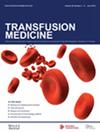A rapid review of strategies to manage low iron levels in adults donating whole‐blood: A focus on donor behaviour
IF 1.5
4区 医学
Q3 HEMATOLOGY
引用次数: 0
Abstract
In recognition of the impact of whole‐blood donation on body iron stores, there has been an increased focus assessing the efficacy of strategies to minimise the risk of iron deficiency (ID). Whilst donor behaviour is an important determinant of success, this literature is yet to be fully synthesised to help guide blood collection agencies when implementing these strategies into routine practice. This rapid review identifies strategies for management of low iron, how they have been communicated to donors, donor compliance with advice, donor use of external health services and their effect on donor retention. Web of Science, Medline, CINAHL and Wiley online library databases were searched from 2012 to November 2023, with 29 studies meeting inclusion criteria. Five iron management strategies were identified: oral iron supplementation (IS), education, dietary advice, lengthening inter‐donation interval and switching donation type. Most studies (对成人全血捐献者低铁含量管理策略的快速审查:关注捐献者行为
由于认识到全血捐献对体内铁储存的影响,人们越来越重视评估各种策略的效果,以最大限度地降低缺铁(ID)风险。虽然献血者的行为是决定献血成功与否的重要因素,但这些文献仍有待全面总结,以帮助指导采血机构在日常实践中实施这些策略。本快速综述确定了低铁管理策略、如何向献血者传达这些策略、献血者对建议的依从性、献血者对外部医疗服务的使用情况及其对献血者保留率的影响。我们检索了 2012 年至 2023 年 11 月期间的 Web of Science、Medline、CINAHL 和 Wiley 在线图书馆数据库,共有 29 项研究符合纳入标准。研究确定了五种铁管理策略:口服铁补充剂(IS)、教育、饮食建议、延长捐献间隔时间和转换捐献类型。大多数研究(n = 16)侧重于口服铁质补充剂,只有四项研究报告了如何向捐献者传达这一信息。在受控研究环境中,捐献者对 IS 的使用率很高,但在常规实践中实施时却未进行评估。关于饮食建议的四项研究中,没有一项包含关于捐献者接受度的研究结果。研究发现,捐献者就低铁结果或 ID 风险咨询医生的比例并不理想。不过,总的来说,已确定的策略和沟通方式对捐献者的保留有积极作用。对于如何提高捐献者对与捐献相关的 ID 风险的了解和认识,以及确定如何有效地向捐献者传达策略以确保最佳的接受度和使用率,还需要更多的证据。
本文章由计算机程序翻译,如有差异,请以英文原文为准。
求助全文
约1分钟内获得全文
求助全文
来源期刊

Transfusion Medicine
医学-血液学
CiteScore
2.70
自引率
0.00%
发文量
96
审稿时长
6-12 weeks
期刊介绍:
Transfusion Medicine publishes articles on transfusion medicine in its widest context, including blood transfusion practice (blood procurement, pharmaceutical, clinical, scientific, computing and documentary aspects), immunohaematology, immunogenetics, histocompatibility, medico-legal applications, and related molecular biology and biotechnology.
In addition to original articles, which may include brief communications and case reports, the journal contains a regular educational section (based on invited reviews and state-of-the-art reports), technical section (including quality assurance and current practice guidelines), leading articles, letters to the editor, occasional historical articles and signed book reviews. Some lectures from Society meetings that are likely to be of general interest to readers of the Journal may be published at the discretion of the Editor and subject to the availability of space in the Journal.
 求助内容:
求助内容: 应助结果提醒方式:
应助结果提醒方式:


